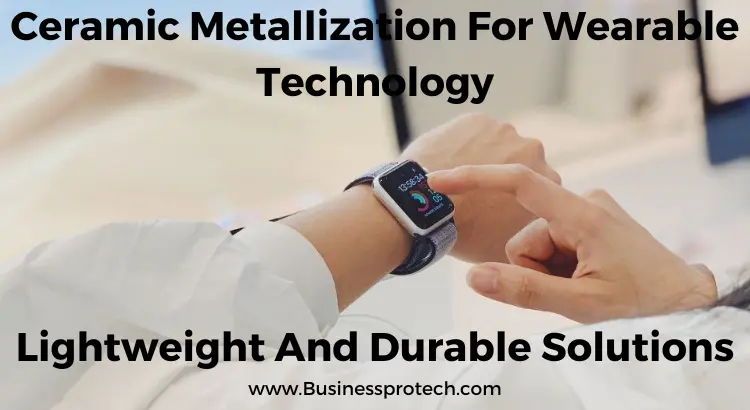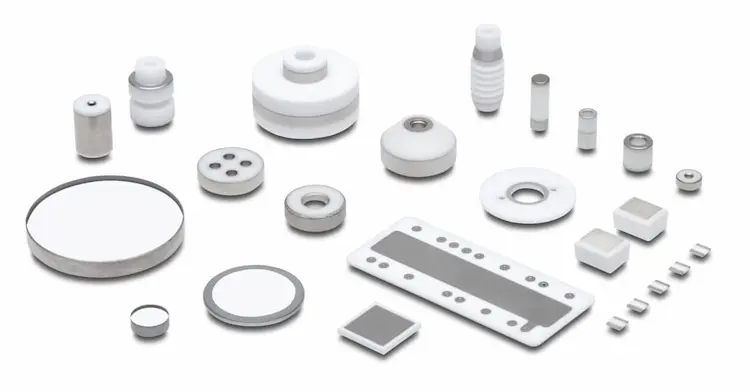Wearable technology, from smartwatches to fitness trackers and from medical devices to smart textiles, has permeated many aspects of our daily lives. These devices, often miniaturized, portable, and expected to be resilient, are pushing the boundaries of material science. To meet these demanding requirements, a promising approach is a ceramic metallization, which is emerging as an innovative solution for lightweight, durable wearable technology.
This article aims to shed light on this fascinating interplay of ceramic and metal and its implications for the future of wearable technology.

Also Read: Things to Consider Before Hiring an Android Wearable App Development Company
Understanding Ceramic Metallization
Ceramic metallization, an important development in materials science, involves the integration of a metallic layer with a ceramic substrate. The result of this merging process is a unique material that combines the best features of both ceramics and metals.
Ceramics And Metals
Ceramics, notably high thermal conductivity ceramics, offer a range of benefits, such as resistance to high temperatures and corrosion, along with electrical insulation. Metals, in contrast, are well-regarded for their high thermal and electrical conductivity. By combining these properties, we achieve a material that exhibits enhanced durability, superior thermal management, and optimal electrical properties.
Techniques For Ceramic Metallization
The process of ceramic metallization can be achieved through several techniques, each carrying unique characteristics and suitable for different applications. The chosen method typically depends on the desired properties of the end product.

Molybdenum-Manganese (Mo/Mn) Metallization
One such method is Mo/Mn metallization. This technique involves the application of Mo/Mn pastes onto the ceramic surface, which is then fired at high temperatures in a controlled environment. This process forms a dense, adherent metallic layer on the ceramic, offering a balance of thermal and electrical properties.
Tungsten (W) Metallization
Another technique is tungsten metallization. In this process, a tungsten paste is applied to the ceramic surface and then subjected to high-temperature firing. The result is a highly adherent metal-ceramic interface with excellent thermal and electrical conductivity.
Active Metal Brazing
A third method, active metal brazing, uses a filler metal to bond the ceramic and metal layer. This process typically occurs in a vacuum or a controlled atmosphere, resulting in a strong, clean bond. The produced composite is high-strength and has excellent thermal management properties.
The Importance of High-Temperature Firing
Regardless of the method, a critical step in ceramic metallization is high-temperature firing. This step ensures the metallic layer’s strong adhesion to the ceramic substrate, creating a composite material that can withstand rigorous conditions without delamination or degradation.
The Marvel of Metal-Ceramic Composite
The resulting metal-ceramic composite is a marvel of modern materials science. Offering exceptional durability and excellent thermal management—thanks to high thermal conductivity ceramics—this material has many potential applications, including wearable technology.
Such composites stand at the forefront of materials science, playing a vital role in the evolution of next-generation devices that meld technology and user comfort seamlessly.
Applications in Wearable Technology
Wearable technology’s rapid advancement has enhanced many aspects of our lives, from personal fitness to healthcare, communication to entertainment. As we dig deeper into the potential applications of ceramic metallization in wearable technology, the utility of this unique material becomes more apparent.

Enhanced Durability
One of the most prominent applications of ceramic metallization in wearable technology is the substantial improvement in durability it offers. Traditional materials used in wearable technology, like plastics and metals, can suffer from wear and tear due to continuous exposure to various environmental factors.
For instance, consider fitness trackers constantly exposed to sweat, UV light, and mechanical stress. With the corrosion resistance of ceramics and the sturdiness of metals, ceramic metalized fitness trackers would be incredibly resistant to these factors, potentially enhancing their operational life significantly.
Lightweight And Comfortable
Comfort and weight are crucial factors when designing wearable technology, as users often wear these devices throughout the day. The smart glasses technology sector exemplifies this point. Regular eyeglasses are designed to be lightweight and comfortable for all-day use, and the same requirements extend to smart glasses.
Thanks to ceramic metallization, smart glasses could maintain a thin profile and lightweight structure while also ensuring durability, enabling a comfortable wearing experience without compromising the device’s resilience.
Improved Thermal Management
The increasing complexity and functionality of wearable technology often lead to thermal management issues due to miniaturized components. Take wearable medical devices, for example. It continuously monitors vital signs or delivers medication, which may cause overheating. As a result, the heat can affect not only the device’s functionality but also potentially harm the user.
However, thanks to ceramic metallization’s high thermal conductivity, such wearable devices can effectively manage heat dissipation, ensuring both the device’s longevity and the user’s safety.
Electrical Conductivity And Insulation
In wearable technology, the miniaturization of electrical components requires effective electrical insulation for user safety while also ensuring efficient electrical conductivity for device operation.
A prime example can be found in smart textiles, designed with embedded sensors for various purposes, such as tracking physical activity or monitoring health parameters. Ceramic metallization in these smart textiles could provide the needed electrical conductivity for the sensors and the necessary insulation to prevent any electrical leakage or short circuits, thereby ensuring user safety.
Aesthetics
A crucial aspect of wearable technology’s widespread acceptance is its aesthetic appeal. The interplay of ceramics and metals in ceramic metallization can lead to a variety of visually appealing finishes.
Imagine a smartwatch or a piece of smart jewelry that leverages ceramic metallization. The shimmering metallic gleam combined with the smooth, premium feel of ceramics could create highly attractive wearables that seamlessly blend technology and fashion.
Bio-Compatibility
Bio-compatibility is an essential consideration in wearable technology, especially for devices designed to have direct contact with the skin for prolonged periods or even be implanted in the body. Ceramic metallization provides a solution here.
Ceramic materials are generally non-reactive and do not irritate the skin or body tissues, making them suitable for wearables like heart rate monitors, smart patches, or even advanced applications like subdermal implants.
Meanwhile, the metallic component of the composite enhances the device’s functionality, offering high thermal and electrical conductivity. This way, ceramic metallization allows the development of bio-compatible wearables that are both safe for long-term or intimate contact with the body and functionally efficient.
Conclusion
With its myriad of advantages, ceramic metallization holds the potential to revolutionize the wearable technology landscape. The ability to combine the best of two material worlds, creating a new breed of lightweight yet durable solutions, is opening exciting possibilities.
As the demand for wearable technology continues to surge, research into ceramic metallization is bound to intensify, and its application in wearables will undoubtedly increase, enriching your everyday technological experiences with greater comfort, style, and longevity.
